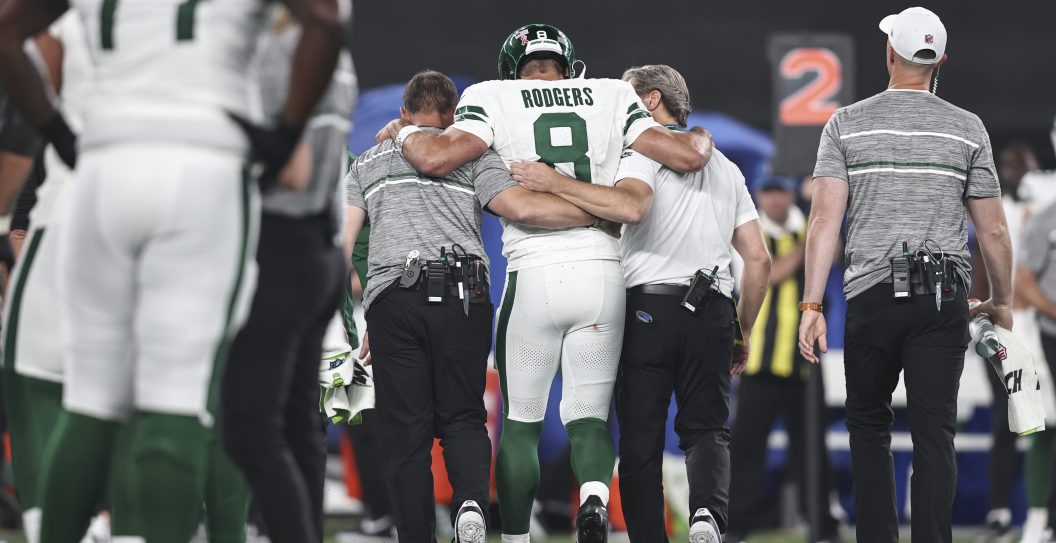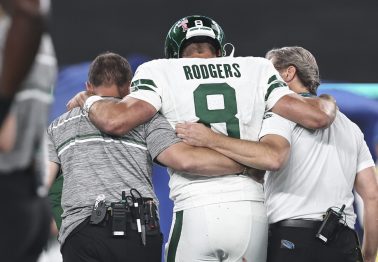The moment Aaron Rodgers sat down on the artificial turf at MetLife Stadium, later diagnosed with a torn Achilles, didn't just potentially torpedo the Jets' once promising season, but the injury was the latest spark to ignite a tinderbox among NFL players over the surface the game and grass vs turf is played on in 15 stadiums across the league.
"My opinion on this issue has been out there for 28 years," prominent NFL agent David Canter, who represents the likes of Cowboys EDGE Demarcus Lawrence, Dolphins safety Xavien Howard, and Bills defensive end Gregory Rousseau, among others, told FanBuzz. "Ban turf. Extend careers."
Rodgers' injury, at age 38, is potentially career-ending, and it occurred just four snaps into his Jets tenure. But, the injury brought new light to the debate that has made the players and their union apoplectic in recent years.
"Moving all stadium fields to high quality natural grass surfaces is the easy decision the NFL can make," Howell's statement began. "The players overwhelmingly prefer it and the data is clear that grass is simply safer than artificial turf. It is an issue that has been near the top of the players' list during my team visits and one I have raised with the NFL.
A statement from our Executive Director Lloyd Howell on #NFL field surfaces: pic.twitter.com/pPsfve8W6j
— NFLPA (@NFLPA) September 13, 2023
"While we know there is an investment to making this change, there is a bigger cost to everyone in our business if we keep losing out best players to unnecessary injuries."
Over the past several seasons, MetLife Stadium has been a flashpoint in the move to ban turf surfaces.
Back in 2020, five San Francisco 49ers players were injured against the Jets at MetLife Stadium, including Nick Bosa and Solomon Thomas being lost for the season. Giants wide receiver Sterling Shepard suffered a torn ACL and a ruptured Achilles tendon in East Rutherford. Just last season, Ravens head coach John Harbaugh sounded off after safety Kyle Fuller tore his ACL, against the Jets, in Week 1 at MetLife.
"That turf was matted down, it was packed down, it was a little tight," Harbaugh said, via ESPN.
Just this offseason, MetLife Stadium replaced the turf surface ... with a new FieldTurf CORE system. In just the second game hosted by the facility this season, the turf is once again in the crosshairs.
"Turf should be banned everywhere football is played," Canter reiterated. "It's a friction surface that doesn't allow for the cleat to move or come out of the ground, and it's a career-killer. Laying plastic carpet over concrete is just greed, with zero concern for the men who sacrifice so much to play the sport."
Unfortunately, for the NFL and its players, there is no perfect solution.
"The issue is that grass isn't perfect either," FanBuzz NFL Injury Analyst Will Caroll said. "JK Dobbins can attest to that, suffering the same injury on a well tended grass field the same weekend as Rodgers. The issue in the NFL has been that they don't use the same turf types, don't really have standards, and the care and maintenance isn't the same. The MetLife field is turf because they need quick turnover and have a lot of events. Same in Charlotte.
"No one's proven one turf type, or grass type, or hybrid is "better." I'd love to see the league do a study, set standards they can enforce for any of them, limit the variance in surface, and study the shoes to see how they contribute."
The economics of hosting multiple events in a stadium; concerts, monster truck rallies, etc. do create a hurdle. However, Taylor Swift played Philadelphia's Lincoln Financial Field, Denver's Empower Field at Mile High, and others this summer, which should underscore the ability to protect a grass field and allow a venue to be used way more frequently than 8-9 weekends a year.
Meanwhile, Rodgers' teammate Randall Cobb pulled no punches on the issue, and left no doubt about what he believes played a major role in the four-time MVP's injury.
"We wanted the NFL to protect the players with grass fields, but the NFL is more worried about making money," Cobb told reporters. "Profit over people, it's always been the case. I've never been a fan of turf. That's my stance."
When the FIFA World Cup hits American shores in 2026, the governing body insisted on grass playing surfaces, prompting AT&T Stadium in Dallas and SoFi Stadium in Los Angeles, among others, to switch from artificial grass to turf. Those moves heightened concern over turf's harm among NFL players and the agents who represent them.
To get a sense for what is driving the conversation, and just how vital the issue of grass playing surfaces vs. artificial turf is to player safety, FanBuzz spoke to more than a half dozen agents who represent players from across the NFL for their thoughts on the issue. Each agent was offered the opportunity to speak anonymously in order to speak candidly and without fear of retribution from any team, or the league itself.
Here are their thoughts;
Agent No. 1
"I'm a strong supporter of switching to all grass playing surfaces. My playing career ended due to an ACL tear on a turf field. Therefore, I'm fully supporting the NFLPA on this subject.
"Our players deserve better, and these organizations have more than enough capital to maintain a natural grass playing surface in every stadium around the league."
Agent No. 2
"If the fact that the World Cup won't play on turf doesn't tell you how little the NFL cares about players, than I don't know what will."
Agent No. 3
"I'm not a scientist, but I've never talked to a single player who said that they prefer turf over grass. That simply tells me everything I need to know."
Agent No. 4
"For me, I think it's pretty simple. Especially if you look back at that 49ers game against the Jets a few years ago when Nick Bosa and several other players with down with season-ending injuries that season due to the turf. That one sticks out to me, just because of the amount of players who went down that day. Personally, I'd love to see a shift to all grass."
Agent No. 5
"As a former college player, I have played on both and I will take grass every day of the week over any synthetic surface"
Agent No. 6
"I think we have pretty conclusive studies and data that turf fields increase the risk of injury, particularly in knees, ankles, and feet. It is definitely a concern for my clients.
"There are of course other variables that come into play, with sloppy fields, when there are poor conditions on grass, as well as weather considerations in general with indoor vs outdoor spaces. In general, from a lower body injury concern point of view, it seems to be more risky with turf and players are certainly aware which raises another issue with the mental aspect. If you have in the back of your mind that an injury is risky it can can increase the odds as well."
Agent No. 7
"Some of these guys feel like they've played on different surfaces, and they noticed obviously — when you lace up the cleats, buckle the chin-strap, you're not thinking about an injury, but if you are, the probability is you're getting injured.
"Think of it like this ... if you're an ice-fisher, and you know parts of the ice are ultra-thin, you're going to avoid that. Look, they need to play, whatever the surface is, they're bound by their contract to play. But, the concern is, you just never know. I could be a casualty through bad turf. Let's face it, if you don't have that protection in your contract, or your P-5 guarantee, I know as long as it's not outside the scope of paragraph 3 of a contract, you're still going to get guarantee for the year, but after that? Who knows."

